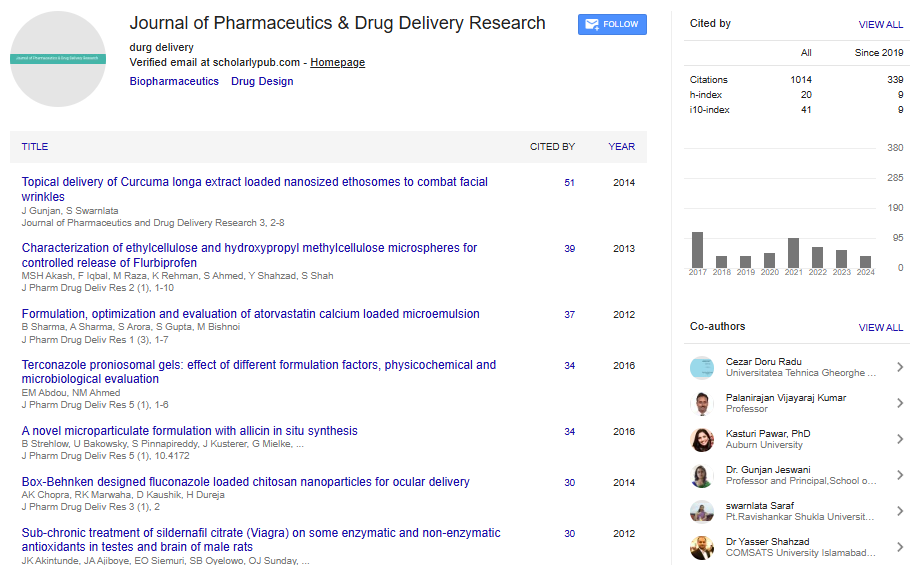Commentary, J Pharm Drug Deliv Res Vol: 13 Issue: 3
The Study of Transdermal Drug Types: A Pathway to Effective Drug Delivery
Sharieh Hosseini*
1Department of Pharmacology, Yale University School of Medicine, New Haven, USA
*Corresponding Author: Sharieh Hosseini,
Department of Pharmacology, Yale
University School of Medicine, New Haven, USA
E-mail: hosseinis57@gmail.com
Received date: 29 April, 2024, Manuscript No. JPDDR-24-143289;
Editor assigned date: 02 May, 2024, PreQC No. JPDDR-24-143289 (PQ);
Reviewed date: 16 May, 2024, QC No. JPDDR-24-143289;
Revised date: 23 May, 2024, Manuscript No. JPDDR-24-143289 (R);
Published date: 31 May, 2024, DOI: 10.4172/2325-9604.1000280
Citation: Hosseini S (2024) The Study of Transdermal Drug Types: A Pathway to Effective Drug Delivery. J Pharm Drug Deliv Res 13:3.
Description
Transdermal Drug Delivery Systems (TDDS) have revolutionized the way medications are administered, offering an alternative to traditional methods such as oral or intravenous routes. These systems deliver drugs through the skin, providing steady and controlled release over extended periods. This method is particularly advantageous for patients requiring long-term treatment or those with difficulty swallowing pills. In this article, we will delve into the various types of transdermal drugs, exploring their mechanisms, applications, and benefits.
Nicotine patches are among the most well-known transdermal systems. Designed to help smokers quit, these patches release nicotine through the skin into the bloodstream, reducing withdrawal symptoms and cravings. The steady delivery mimics the nicotine levels from smoking, aiding in gradual cessation.
Hormonal patches, such as those used in Hormone Replacement Therapy (HRT) or birth control, provide consistent delivery of hormones like estrogen or progestin. They offer an alternative to oral contraceptives, reducing the risk of gastrointestinal side effects and improving patient compliance.
Pain relief patches, like those containing fentanyl or lidocaine, are used to manage chronic pain. They deliver medication directly to the affected area or systemically through the skin, providing sustained relief and reducing the need for frequent dosing.
Clonidine patches, used for hypertension, offer a unique advantage for patients with fluctuating blood pressure. These patches maintain stable drug levels, reducing the peaks and troughs associated with oral administration and improving overall blood pressure control.
Gels and creams containing Non-Steroidal Anti-Inflammatory Drugs (NSAIDs), such as diclofenac or ibuprofen, are popular for treating localized pain and inflammation. These formulations penetrate the skin to reach the underlying tissues, providing targeted relief with minimal systemic side effects.
Hormonal gels, used in conditions like menopause or testosterone deficiency, offer another method for delivering hormones. These gels are applied to the skin, where they are absorbed and circulate in the bloodstream, providing a steady hormone supply without the need for injections or oral tablets.
Local anesthetic creams and gels, such as those containing lidocaine, are used to numb specific areas of the skin or mucous membranes. They are commonly applied before minor surgical procedures or to alleviate pain from conditions like shingles or dental procedures.
Nitroglycerin sprays are used in the management of angina pectoris. These sprays are applied to the skin, where they are rapidly absorbed, providing quick relief from chest pain by dilating blood vessels and improving blood flow to the heart.
Antifungal sprays, such as those containing clotrimazole or terbinafine, are used to treat fungal infections like athlete's foot or ringworm. They provide direct application to the infected area, ensuring effective drug delivery with minimal systemic absorption.
Iontophoresis is a technique that uses a small electrical current to enhance the delivery of drugs through the skin. This method is particularly useful for drugs that are difficult to deliver transdermally due to their size or charge.
Lidocaine iontophoresis is commonly used for local anesthesia in dental procedures or minor surgeries. The electrical current facilitates the rapid absorption of lidocaine through the skin, providing effective and quick pain relief.
While still under research, iontophoresis holds potential for delivering insulin to diabetic patients. This method could offer a noninvasive alternative to insulin injections, improving patient comfort and adherence to treatment regimens.
Micro-needle patches represent a cutting-edge advancement in transdermal drug delivery. These patches contain tiny needles that painlessly penetrate the outer layer of the skin, creating microchannels that facilitate drug delivery directly to the underlying tissues.
Micro-needle patches are being explored for vaccine delivery, offering a needle-free and painless method to administer vaccines. This approach could revolutionize immunization, especially in regions with limited healthcare resources.
Biologic drugs, such as monoclonal antibodies, are typically administered via injection. Micro-needle patches provide a promising alternative, allowing these large molecules to be delivered through the skin, potentially reducing the need for injections and improving patient compliance.
Conclusion
Transdermal drug delivery systems offer a versatile and effective method for administering a wide range of medications. From patches and gels to innovative micro-needle technologies, these systems provide numerous benefits, including improved patient compliance, steady drug release, and targeted delivery. As research and technology continue to advance, the scope of transdermal drug delivery will expand, providing new and improved treatment options for patients worldwide.
 Spanish
Spanish  Chinese
Chinese  Russian
Russian  German
German  French
French  Japanese
Japanese  Portuguese
Portuguese  Hindi
Hindi 
